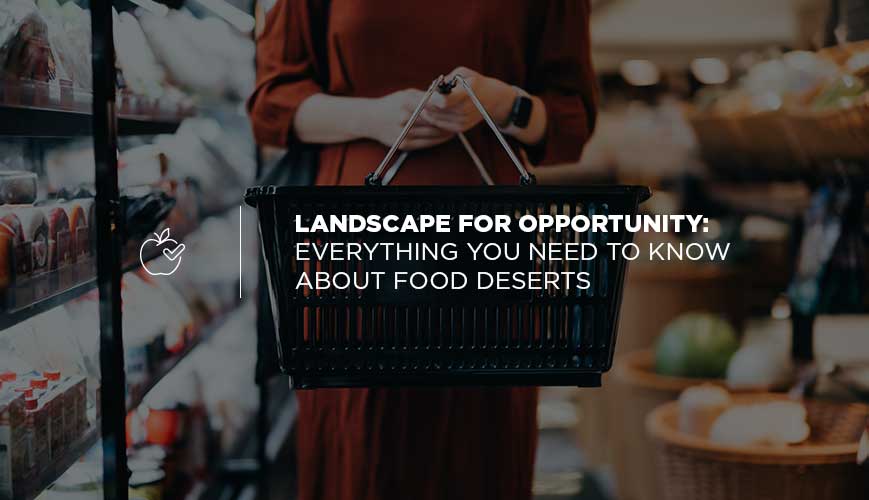Landscape for Opportunity: Everything You Need to Know About Food Deserts
By Martha Michael

Residents in parts of the country with little access to healthy nutritional options are living in “food deserts.” To counteract the negative effects of this reality there are many who seek to provide an oasis of healthy options, an environment where fresh food is plentiful and clean water flows.
What Are Food Deserts?
Multiple factors contribute to the rise of food insecurity and create pockets of residents who are either too far from sources of fresh fruits and vegetables, whole grains, dairy and meat, or the healthy food that is available is cost prohibitive.
An article by Medical News Today uses the definition of a food desert from the U.S. Dept. of Agriculture, which is “an area that has either a poverty rate greater than or equal to 20 percent or a median family income not exceeding 80 percent of the median family income in urban areas, or 80 percent of the statewide median family income in nonurban areas.”
In addition, to be defined as a food desert, 33 percent of the population must be more than a mile from the nearest market for urban residents and more than 10 miles away in rural communities.
In the early part of this century the USDA identified approximately 6,500 food deserts; today experts estimate that more than 23 million Americans in low-income areas live more than a mile from a grocery store.
Neighborhoods that become food deserts tend to have the following characteristics:
- Low-income families
- Little access to transportation
- High unemployment
- Inadequate number of food retailers with fresh produce
- Very populous or sparsely populated settings
Not all rural areas have the same tendency, however. Small towns with growing populations are less likely to become food deserts. The rural South, Midwest and western United States are more likely to become food deserts than other parts of the country. Race can also play a part in the process. Low-income neighborhoods with minority groups have less access to grocery stores than white, wealthy residents. Effects of Living in a Food Desert.
People experiencing food insecurity have far greater challenges to their physical health. With less access to healthy nutrition, those living in food deserts have a higher risk of several chronic diseases leading to death or disability, according to nonprofit public health organization Esperanca. They include:
- High blood pressure
- Cancer
- Stroke
- Type 2 diabetes
- Heart disease
Residents in food-insecure communities also suffer from higher rates of obesity, which leads to health problems, and eating habits that are typically intergenerational, which means the cycle is passed on to children and grandchildren. People in food deserts often shop at corner convenience stores purchasing processed, packaged foods that are easy to access and prepare but have little nutritional value. These retailers are sometimes misidentified as sources of healthy produce which means the existence of food deserts is often underreported.
Food insecure residents with allergies or sensitivities face a greater challenge finding safe nutritive choices, which can be life-threatening. For malnourished pregnant women lacking adequate levels of Vitamin A and iron, there’s a higher prevalence of miscarriages and birth defects.
What We Can Do
The obvious way to turn food deserts into bountiful landscapes is through policy changes, which aren’t accomplished with minimal effort and take a long time to finalize. Expanding resources to create more equity is a complex problem to solve.
There are some expedient ways that individuals can come together to make a difference, says an article by Healthline. Some community groups are working to develop a surplus food sharing program in their towns. Advocacy groups collect excess food from restaurants and pick up produce from grocery stores for distribution to needy families.
Wealthy and well-off residents contribute to such nonprofit programs as Meals on Wheels and local food banks that provide food to the underserved. If your town has a community garden, it’s another way to make a difference in raising produce for members of the community. Getting food-insecure individuals involved helps them gain the nutritional benefits while also learning to plant and grow fresh food.
Thankfully, it isn’t just the residents of food deserts who thirst for change in the landscape of nutritional opportunity. Anyone can get involved in solving the problem.
If you know someone experiencing food scarcity, you can refer them to a local food bank. For immediate assistance call the USDA’s National Hunger Hotline at 866-3-HUNGRY on weekdays from 7 a.m. to 10 p.m. EST.
Unfortunately, this problem won’t resolve itself overnight; there will be hunger pains along the way. But knowledge is the first step toward bridging the gap between the haves and have nots.
The information, including but not limited to, text, graphics, images and other material contained on this page are for informational purposes only. The purpose of this post is to promote broad consumer understanding and knowledge of various health topics, including but not limited to the benefits of chiropractic care, exercise and nutrition. It is not intended to provide or be a substitute for professional medical advice, diagnosis or treatment. Always seek the advice of your chiropractor, physician or other qualified health care provider with any questions you may have regarding a medical condition or treatment and before undertaking a new health care regimen, and never disregard professional medical advice or delay in seeking it because of something you have read on this page.